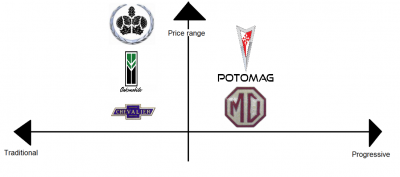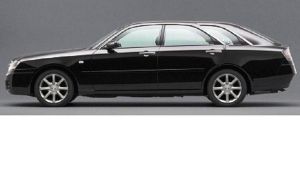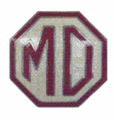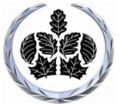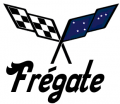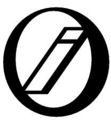Consolidated Motors Corporation
| Consolidated Motors Corporation | |
|---|---|

| |
| Type | Privately held company |
| Slogan | A car for each kind of people |
| Founded | 1908 |
| Location | Bridgeport, Connecticut, NAL |
| Key people | Frederick Henderson (CEO) |
| Employees | 100 000 |
| Industry | Automotive industry |
| Products | Automobiles, trucks and buses |
| Revenue | |
Consolidated Motors Corporation (in IB English Consolidated Motors Corporacion), also known as CM, is the third largest car manufacturer (after Toiota from Japan and Dorris Motorworks from Louisianne) based on annual sales figures. It is one of the so-called "Big Three", the three largest car manufacturers of North America (the others are Dorris Motorworks and National Motors Corporation).
Founded in 1908, CM employs approximately 100 000 people around the world. CM manufactures its cars and trucks in seven countries: the NAL, the Federated Kingdoms (since 1925), Australasia (since 1926), South Africa (since 1974), Samraj (since 1928), Canton (since 1997) and Paraná (since 1930).
CM cars and trucks are sold globally under the following ten brands: Adirondack, Chevalier, CMD, Dover, Fauxhall, Globus, Jupiter, Minuit, Oaksmobile and Potomag. It also has several minority stakes in other automotive corporations around the world, some of those also sell badge engineered CM models, so as developed strategic partnerships through cross-sharing agreements.
CM’s largest national markets are the NAL, the Federated Kingdoms, Australasia, Samraj, Nanhanguo, Canton and Paraná. In recent years it has made inroads into the Louisiannan market, as well.
History
Early history
Consolidated Motors was founded in 1908 by the union of two car manufacturers from Bridgeport, Connecticut, NAL, the Chevalier Motor Company (owned by the French brothers Gaston and Louis Chevalier) and Maxwell Dover Motors (owned by Richard Maxwell and Joseph Dover), producer of the MD car line.
Such a union was primarily thought to compete with other NAL manufacturers. The Chevalier brothers had the majority of the shares.
Expansion
In 1915, CM acquired the Lla Daf di Meginober Potomag, Llifidad (The Potomack Machinery Company, Limited) from Balafor, Ter Mair. Later, in 1918, it acquired a luxury brand, Adirondack Autofabriek, from Adirondack, Castreleon New. By then CM was the largest of all car making corporations in the NAL.
Exports started in 1919, at first to other North American countries, then in 1921 overseas. The Federated Kingdoms were the first non-American country to import CM cars and first foreign country where a CM car factory was built, in 1925. Here it had a certain success which caused the shareholders to consider that Europe would be a good export market. During this period CM established factories in Paraná, Samraj and Australasia, becoming the carmaker present in the largest number of continents.
In 1929, CM tried to establish a subsidiary in mainland Europe for the fist time. CM made a large loan to the banks in order to take over a major German car manufacturer, Adam Opel AG from Hessen. CM offered to the Opel shareholders an amount for each share larger than their value. But CM was only able to take one third of Opel’s shares. Possibly there was some kind of intervention or pressure from the German government to avoid the stock exchange operation.
CM then found itself in a delicate financial situation as the result of a large debt to the banks. It was forced to sell its shares in Adam Opel and even then was unable to avoid being taken over by the banks. The original CM’s founders then lost the control of the corporation, although Louis Chevalier was kept as honorary president until his death. CM was reorganized as its subsidiaries (Dover, Chevalier, Potomag and Adirondack) lost much of their autonomy becoming divisions of the newly formed Consolidated Motors Corporation of the Americas subsidiary, which included both operations in the NAL and Paraná). The other operations worldwide became CMC of England, CMC of Australasia ands CMC of the Indias.
During this period, the MD car brand was renamed Dover, although the initials MD were kept in the brand’s logo. Adirondack became the official car of the Octagon House serving all general Moderators since Franklin Donald Rosenberg.
Second Great War
The Second Great War was devastating for the European car industry. Most of the local car manufacturers replaced their production with military vehicles and weapons. Also many of the most distinguished continental brands (especially in France and in the Holy Roman Empire) were discontinued and often completely decimated by the war.
In North America car manufacturing continued but without exports to Europe. As a result North American production became smaller, but even so the NAL and Louisianne together represented by then over three quarters of world’s production.
As the NAL participated in the war, CM also produced military vehicles during this period.
Post war
Europe came out of the war in ruins and in a serious economic crisis. Personal transportation was far from being a priority. Public transportation became more important.
CM was not yet able to mass export cars to Europe. Average European families simply could not afford the cheapest Dover. American cars were too large, too transatlantic in character and too thirsty. On the continent some manufacturers restarted production. Notably luxury cars (the wealthy do not always feel the crisis in the same way as the poorer) and a new range of tiny cars of which the famous Egg Car, made by the Bohemian company Ti Frojta Motorverki, was one of the best and most successful examples.
To return to Europe CM created a new brand locally made, Anglia, based in England. In reality, it did not produce own models, just rebadged Dovers and Chevaliers in their most simple presentation. Anglia was able to produce cars in large numbers years later as European reconstruction progressed.
In North America CM was restructured. To avoid sales cannibalisation between its brands (which was happening especially between Potomack and Chevalier) a hierarchy was created based on luxury and prices, the so-called Ladder Program. From now on CM brands would not be competitors within the corporation.
From bottom to top in terms of luxury and price there were now Dover, Chevalier, Potomag, the newly created Oaksmobile and Adirondack. Such marketing strategy would soon be imitated worldwide by other car manufacturers. Another brand was created, CMD, which specialised in medium and heavy duty trucks as well as buses.
Later the Ladder Program was replaced by the Dual Ladder Program. Until early 1960’s each brand had just few models available and the most luxorious model of a certain brand was cheapper than the cheappest model of the following brand in the ladder hierarchy. Some brands, hoping to take a larger share in the market, launched more models moving both down and upmarket. To avoid once again sales cannibilisation brands were divided between progressive and traditional. The progressive ladder included from bottom Dover and Potomag, while the traditional ladder included Chevalier, Oaksmobile and Adirondack. Now despite each brand could have a similarly priced model to other brand each one was given a different “personality” focusing on a different kind of driver.
Recent years
The 1960s represented an expansion era for CM. New factories were built in Australasia, Samraj and South Africa (in 1974). Now CM was present on all the continents.
But in Europe there was a major handicap. Although Europeans now demanded bigger cars, the continental market was still dominated mostly by small ones, still led by the Frojt’s Egg Car. CM needed a range even lower than Anglia to assure success in Europe.
Instead of creating a new brand, CM took control of another English manufacturer, Issigonis, which specialised in small cars, and attempted taking control of Volkswagen without success. But it seemed to be too late. Frojt and others were by then too well established and the Issigonis was no match for the Egg Car. Curiously the Egg Car itself was produced under license by Dover for the North American market.
In 1973, oil prices decreased to historical minimum levels in the so-called Oil Crisis of Hijra 1393. This event had a direct effect on the car industry. The availability of cheap oil made car manufacturers build bigger cars that were less economical. This worldwide tendency was called “upsizing”.
For Issigonis this was bad news and it was discontinued in the mid-1970’s. For the American market CM increased production of its larger models, even in the low- and mid-luxury levels. Potomag especially then had some glorious days with large-engined, ultra-fast cars which were often seen being driven by cinema heroes.
But things changed in 1980. Oil prices increased once again due to the Persia-Iraaq War. For up level luxury cars, notably Adirondack, there was no serious problem as the wealthy could always spend some more. But for the middle class market, it was devastating for Potomag. Since then Potomag brand has lost its public every year. There was then the downsizing process as a general tendency, so cars once again were built smaller.
In the late 1980s there were two marketing failures. Anglia created its own models, and a new brand, Frégate, was created to compete with European high luxury speedy cars. Both operations failed at a tremendous cost to and a serious blow to CM’s international image.
During 2006-07 The Commonwealth Sovereign-Debt Crisis affected most of the Commonwealth of Nations member states. Following austerity measures affected car market causing regression in sales figures in some major CM markets (NAL, FK, Australasia and, especially, South Africa). Rootes Motors closed its South African factory, while English Leyland, Toyota and Volkswagen announced their intention to do the same and ENMW, the only large volume native carmaker, struggled to survive. CMC of Africa was romoured to close operations there either. To avoid car makers to be shut down in South Africa, and consequent unemployment and loss of know how, local government implemented a plan so all car makers would collaborate with each other in order to gain productivity and rationalise their resources.
Elsewhere CM developed strategic partnerships with other major car makers in order to make lower new models development costs, notably with French Groupe PCA (Panhard-Citroën-Amilcar Group), taking advantage of the French experience for developing small cars. In exchange CM offered its experience in making large cars.
In recent years four brands were added to CM's brands portfolio to fill several perceived niche target markets: Minuit (2009), Fauxhall (2010), Jupiter (2012) and Globus (2014).
Today CM remains the third largest car manufacturer in the world and its brands are still loyal to the personality given to them during the 1950’s.
Marketing
Distinguishing the brands
During the 1950s CM created its present motto: “A car for each kind of person”. It was a marketing operation to avoid having each of their car brands cannibalise their sales. So a certain personality was given to each brand which has remained to this day. Such a strategy would be imitated by other car manufacturers around the world.
Dover
Dover, one of the original CM brands, was always traditionally the bottom of the range within the corporation. It had always produced cheap and simple cars. Until the 1970s it was the best selling brand but Chevalier took this position when cars became bigger in the upsizing process.
Lately, Dover has become sportier in order to compete with Asian car imports and to appeal to young drivers.
Together with Chevalier it is the only brand also produced overseas.
Chevalier
The Chevalier is the perfect example of a mainstream generalist brand. It has a full range of all sorts of cars, from small to large, including off road vehicles and light commercials. Today this best selling CM brand is responsible for more than half of all cars sold by the corporation. Chevaliers are meant to be popular cars but are not as basic as the Dovers.
This is also known by its nickname, Chevy.
Potomag
Until the reforms of the 1950s, Potomag had a position similar to Chevalier. It is with these two brands that sales cannibalisation was most visible. Then the Potomag was moved upmarket becoming a sporty mid-luxury brand in order to compete against the Astra car line from Dorris Motorworks. Potomag built a solid recognised name throughout the world by their successes in car racing and by producing some of the most legendary CM models.
Sales progressed until the 1970s when it became the third best selling brand. But when oil prices rose in the early 1980’s, this was the brand which suffered most as its buyers were not rich enough to sustain the increasingly higher oil prices. Since then sales have decreased and it is now the poorest selling brand.
Discontinuance of the Potomag is often discussed lately but its highly recognised name has always saved this brand. In fact for CM, owning a brand with such a racing history and strong name, even without direct profits, does wonders for the image of the corporation around the world.
Oakesmobile
The Oakesmobile brand was conceived during the 1950s to fill the price and luxury gap between Potomag and Adirondack. It was named after Thomas H. Oakes, a former engineer from Chevalier. It became a mid-luxury brand with a certain success. But mid-luxury car imports never let Oakesmobile grow much. It's colloquially known as O-Mobile and its logos variations always depicted a stylicized oak.
Fauxhall
English automaker Fauxhall Motors became CM’s subsidiary on May 2010. Unlike the other eight Fauxhall isn’t wholly owned as CM acquired 55% of its shares on its largest international stock operation since the 1960's when CM tried to take Volkswagen.
CM has a double purpose: on European car market aims to become stronger as Fauxhalls are mainstream European cars, therefore more adapted to local car market than American made or designed models. On American car market Fauxhall is aimed to bring a certain European (and mostly English) car style in order to compete against European luxury and mid-luxury imports. See also: http://groups.yahoo.com/group/conculture/message/36234
Minuit
The recently announced Minuit is one of the youngest of all CM brands. It aims to conquer the European market with rebadged Adirondacks and Potomags, blending luxury and sporting character, and to compete with the main local mainstream luxury brands. It went on sale in December 2009, first in European left hand traffic countries and later in the right hand traffic ones. More recently it started to introduce its own models in a style closer to European one, although all models are made in the NAL exclusively for export.
See also: http://groups.yahoo.com/group/conculture/message/34191
Jupiter
Another recently born CM brand. It was introduced in 2012 in order to compete against Japanese cars in North American Domestic Market (NADM), whatever they are manufactured in North American countries or imported. Although it sells reasonabily well is still far away from its Japanese competitors.
Globus
Globus is a captive import brand born in 2014 for sale in Europe offering lower spec North American car models. It sells a selection of Dover and Chevalier models imported from the NAL. It's headquartered in Luton, England.
Adirondack
The Adirondack is the top of the CM range in terms of luxury. It is known worldwide for its ostentation, luxury, conservativism and high quality. the typical Adirondack is fitted with all the chrome that is possible to put in a single car.
Since General Moderator Franklin Donald Rosenberg made it the official car of the Octagon House (replacing the English Rolls Royce), it has become a highly recognised car in the NAL and overseas. Nowadays only the German Mercedes-Benz serves more world rulers and governments. It is the most used governmental car within the Commonwealth of Nations.
CMD
CMD (Consolidated Motors Diesel) was created during the 1950s for grouping the buses and medium and heavy duty trucks produced by both Chevalier, Dover and Potomag. Since then CMD has become one of the world’s leading truck manufacturing brands.
Defunct brands
Anglia
This new brand for Europe was created in the late 1950s to assault European market. Headquartered in England, the CM manufacturing facilities were grouped under the name Anglia Motor Corporation. It was supposed to become a major car manufacturer for all Europe.
In fact Anglia did not have its own models. Their cars were just rebadged Chevaliers and Dovers under the Anglia logo. Anglia had a certain success selling the cars in Europe.
During the late 1980s Anglia finally introduced its own designed models. But the expected success never occurred and this spelled the end of Anglia during the 1990s. The name was dropped and since then its manufacturing facilities assemble Chevalier and Dover models.
Frégate
In the late 1980s CM decided to compete with the high speed luxury brands from Europe. For that it invested a huge amount of money in making a whole new brand called Frégate, named after the French word for frigate, a warship built for speed and maneuverability. Such name was chosen to give a certain feel of European made upscale sports car.
The Frégate was never supposed to be for mass production as its market was only for the really wealthy. But the wealthy preferred the well establilshed European speedy luxury cars, rather than a brand that had just been created even if its designs were made by some of the most notable car designers of Europe.
It took just four years for the Frégate brand to be abandoned becoming one of the largest failures in recent worldwide car manufacturing history. It also became a symbol of how ingenuous large corporations can be.
Issigonis
Issigonis (named after its founder, the Greek expatriate Alexandros Issigonis), from the Federated Kingdoms, was originally among the English Leyland collection of brands. It was acquired during the mid-1960s in order to compete with the smallest European cars such as the Egg Car from the Bohemian corporation Ti Frojta Motorverki. It was placed in the European market below Anglia. As the upsizing process progressed, Issigonis was deleted from the CM line in the mid-1970’s.
Gallery of Logos
CM worldwide
America
CM remains the best selling car manufacturer in the NAL (over one-third of local sales) as well as in a strong position all over America. Among American manufacturers only Dorris Motorworks is able to compete in sales volume in the American car market.
Europe
The Federated Kingdoms are the only European country where CM remains as a major car-selling company. In mainland Europe CM was never able to compete with local manufacturers mostly due to the late introduction of right-driving cars which just happened during the 1960s when European countries began to approve cars built for driving on the right side of the roads (and therefore with the driving wheel on the left side of the vehicles). Recent strategic partnership with PCA Group intends to give CM a chance in mainland Europe to enter mass market.
Only Adirondack, CM’s high luxury brand, had some success although competition with local luxury manufacturers is rather harsh.
Other continents
CM is the best selling manufacturer in most of the Commonwealth of Nations member states. Since in these countries people drive on the left, CM never needed to convert their cars. This always represented an advantage for FK and NAL car manufacturers within the Commonwealth of Nations. However, in later years, Japanese manufacturers seem to be able to threaten CM's leading position thanks to their cheap cars which are having a great success in Africa and Asia.
